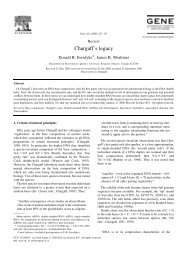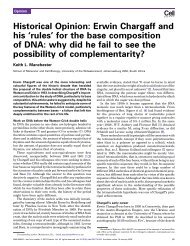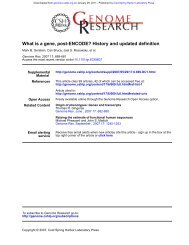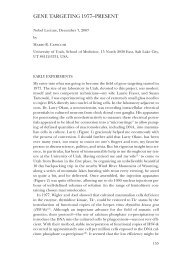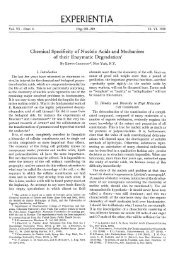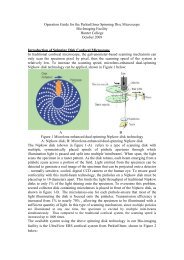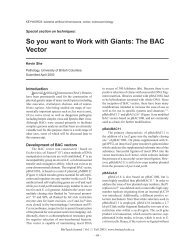Cold Spring Harb Symp Quant Biol-1953-Watson-SQB ... - Biology
Cold Spring Harb Symp Quant Biol-1953-Watson-SQB ... - Biology
Cold Spring Harb Symp Quant Biol-1953-Watson-SQB ... - Biology
You also want an ePaper? Increase the reach of your titles
YUMPU automatically turns print PDFs into web optimized ePapers that Google loves.
Downloaded from symposium.cshlp.org on March 26, 2009 - Published by <strong>Cold</strong> <strong>Spring</strong> <strong>Harb</strong>or Laboratory Press<br />
STRUCTURE OF DNA 127<br />
spaced equally along the fiber axis, but are probably<br />
displaced from each other by about threeeighths<br />
of the fiber axis period, an inference again<br />
in qualitative agreement with our model.<br />
The interpretation of the X-ray pattern of Structure<br />
A (the crystalline form) is less obvious. This<br />
form does not give a meridional reflexion at 3.4 A,<br />
but instead (Figure 2) gives a series of reflexions<br />
around 25 ~ off the meridian at spacings between<br />
3 A and 4 A. This suggests to us that in this form<br />
the bases are no longer perpendicular to the fiber<br />
axis, but are tilted about 25 ~ from the perpendicular<br />
position in a way that allows the fiber to contract<br />
30 per cent and reduces the longitudinal translation<br />
of each nucleotide to about 2.5 A. It should<br />
be noted that the X-ray pattern of Structure A is<br />
much more detailed than that of Structure B and so<br />
if correctly interpreted, can yield more precise information<br />
about DNA. Any proposed model for<br />
DNA must be capable of forming either Structure<br />
A or Structure B and so it remains imperative for<br />
our very tentative interpretation of Structure A to<br />
be confirmed.<br />
(2) The anomolous titration curves of undegraded<br />
DNA with acids and bases strongly suggests that<br />
hydrogen bond formation is a characteristic aspect<br />
of DNA structure. When a solution of DNA is<br />
initially treated with acids or bases, no groups are<br />
titratable at first between pH 5 and pH 11.0, but<br />
outside these limits a rapid ionization occurs (Gulland<br />
and Jordan, 1947; Jordan, 1951). On back<br />
titration, however, either with acid from pH 12 or<br />
with alkali from pH 21,6, a different titration curve<br />
is obtained indicating that the titratable groups are<br />
more accessible to acids and bases than is the untreated<br />
solution. Accompanying the initial release<br />
of groups at pH 11.5 and in the range pH 3.5 to<br />
pH 4.5 is a marked fall in the viscosity and the<br />
disappearance of strong flow birefringence. While<br />
this decrease was originaIly thought to be caused<br />
by a reversible depolymerization (Vilbrandt and<br />
Tennent, 1943), it has been shown by Gulland, Jordan<br />
and Taylor (1947) that this is unlikely as no<br />
increase was observed in the amount of secondary<br />
phosphoryl groups. Instead these authors suggested<br />
that some of the groups of the bases formed hydrogen<br />
bonds between different bases. They were unable<br />
to decide whether the hydrogen bonds linked<br />
bases in the same or in adjacent structural units.<br />
The fact that most of the ionizable groups are originally<br />
inaccessible to acids and bases is more easily<br />
explained if the hydrogen bonds are between bases<br />
within the same structural unit. This point would<br />
definitely be established if it were shown that the<br />
shape of the initial titration curve was the same at<br />
very low DNA concentrations, when the interaction<br />
between neighboring structural units is small.<br />
(3) The analytical data on the relative proportion<br />
of the various bases show that the amount of<br />
adenine is close to that of thymine, and the amount<br />
.of guanine close to the amount of cytosine + 5-<br />
methyl cytosine, although the ratio of adenine to<br />
guanine can vary from one source to another<br />
(Chargaff, 1951; Wyatt, 1952). In fact as the<br />
techniques for estimation of the bases improve, the<br />
ratios of adenine to thymine, and guanine to cytosine<br />
q- 5-methyl cytosine appear to grow very close<br />
to unity., This is a most striking result, especially as<br />
the sequence of bases on a given chain is likely to<br />
be irregular, and suggests a structure involving<br />
paired bases. In fact, we believe the analytical data<br />
offer the most important evidence so far available<br />
in support of our model, since they specifically support<br />
the biologically interesting feature, the presence<br />
of complementary chains.<br />
We thus believe that the present experimental<br />
evidence justifies the working hypothesis that the<br />
essential features of our model are correct and allows<br />
us to consider its genetic possibilities.<br />
V. GENETICAL IMPLICATIONS OF THE<br />
COMPLEMENTARY MODEL<br />
As a preliminary we should state that the DNA<br />
fibers from which the X-ray diffraction patterns<br />
were obtained are not artifacts arising in the method<br />
of preparation. In the first place, Wilkins and<br />
his co-workers (see Wilkins et a/., <strong>1953</strong>) have<br />
shown that X-ray patterns similar to those from<br />
the isolated fibers can be obtained from certain<br />
intact biological materials such as sperm head and<br />
bacteriophage particles. Secondly, our postulated<br />
model is so extremely specific that we find it impossible<br />
to believe that it could be formed during<br />
the isolation from living cells.<br />
A genetic material must in some way fulfil two<br />
functions. It must duplicate itself, and it must<br />
exert a highly specific influence on the cell. Our<br />
model for DNA suggests a simple mechanism for<br />
the first process, but at the moment we cannot see<br />
how it carries out the second one. We believe, however,<br />
that its specificity is expressed by the precise<br />
sequence of the pairs of bases. The backbone of<br />
our model is highly regular, and the sequence is<br />
the only feature which can carry the genetical information.<br />
It should not be thought that because<br />
in our structure the bases are on the "inside," they<br />
would be unable to come into contact with other<br />
molecules. Owing to the open nature of our structure<br />
they are in fact fairly accessible.<br />
A MECHANISM FOR DNA REPLICATION<br />
The complementary nature of our structure, suggests<br />
how it duplicates itself. It is difficult to imagine<br />
how like attracts like, and it has been suggested<br />
(see Pauling and Delbriick, 1940; Friedrich-Freksa,<br />
1940; and Muller, 1947) that self<br />
duolication may involve the union of each part<br />
with an opposite or complementary part. In these<br />
discussions it has generally been suggested that<br />
protein and nucleic acid are complementary to each<br />
other and t~at self replication involves the alternate



